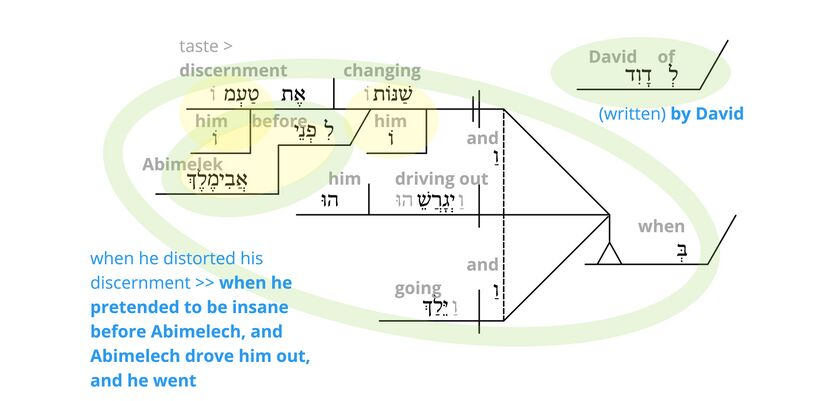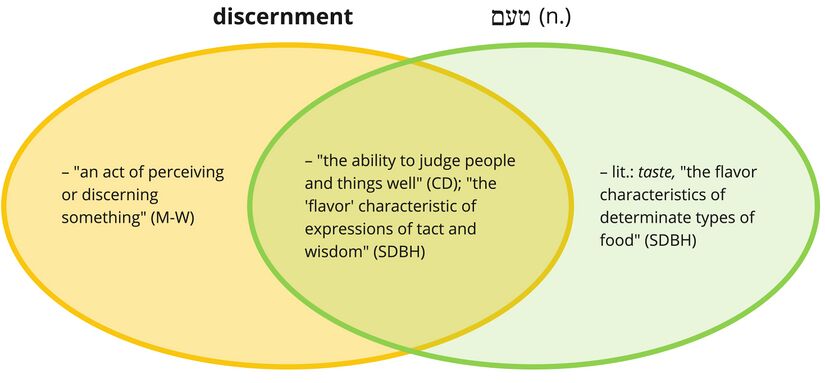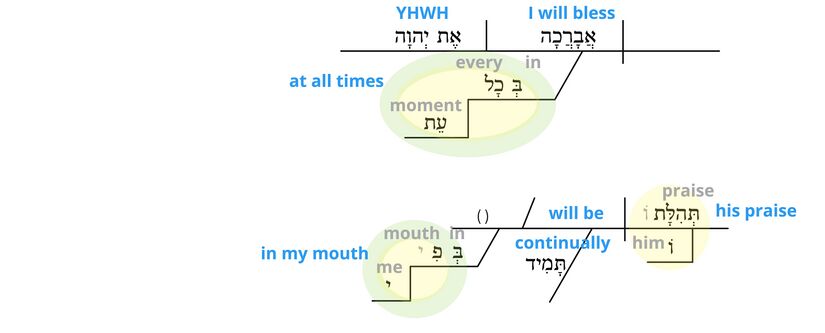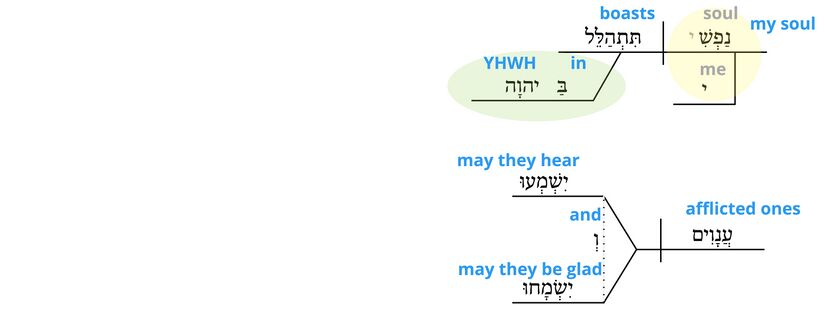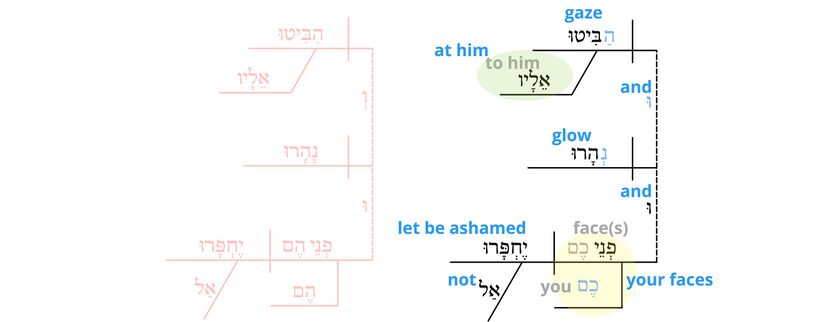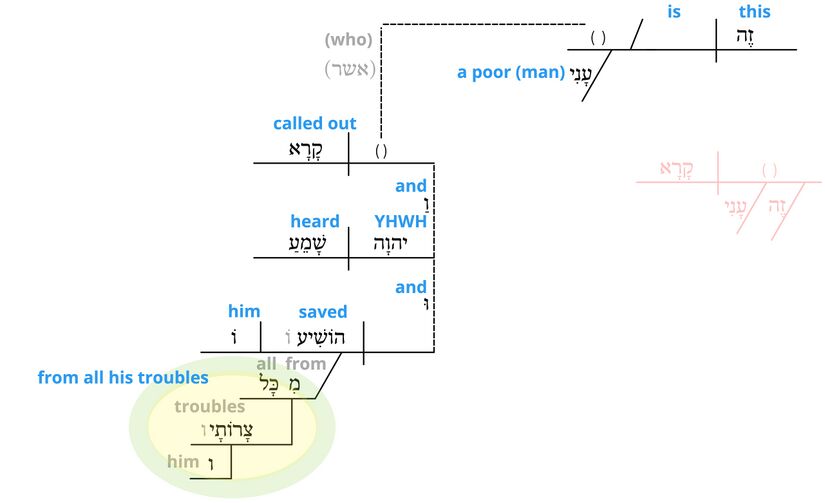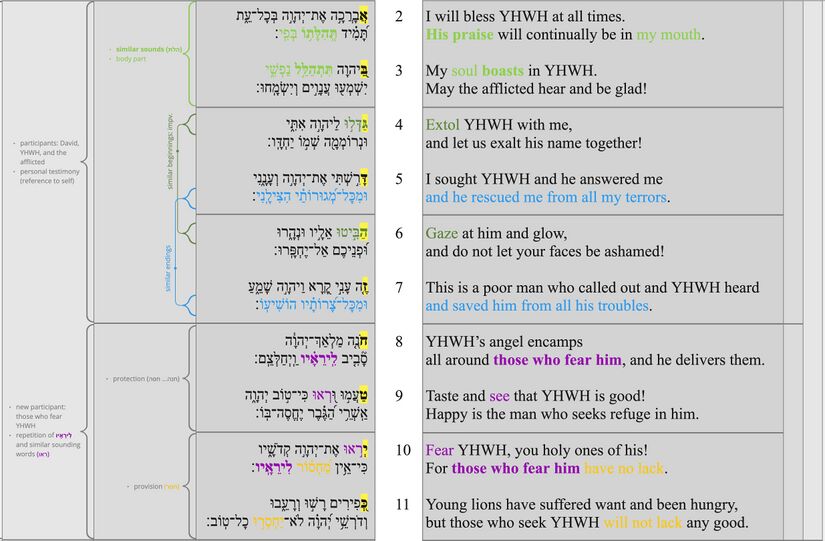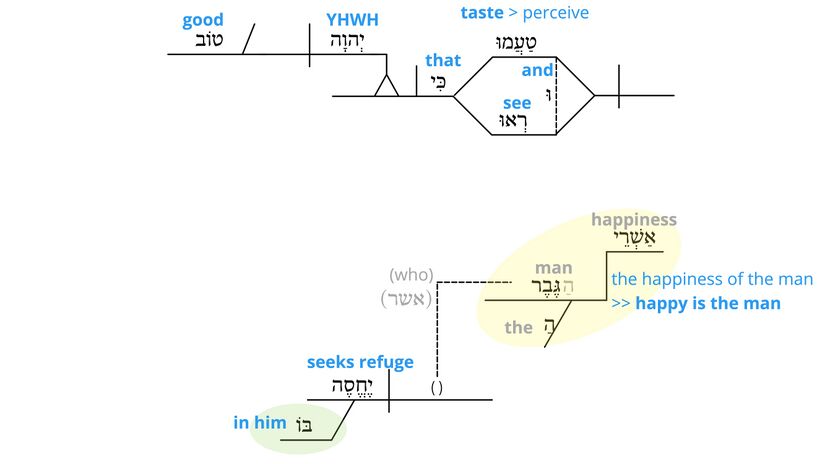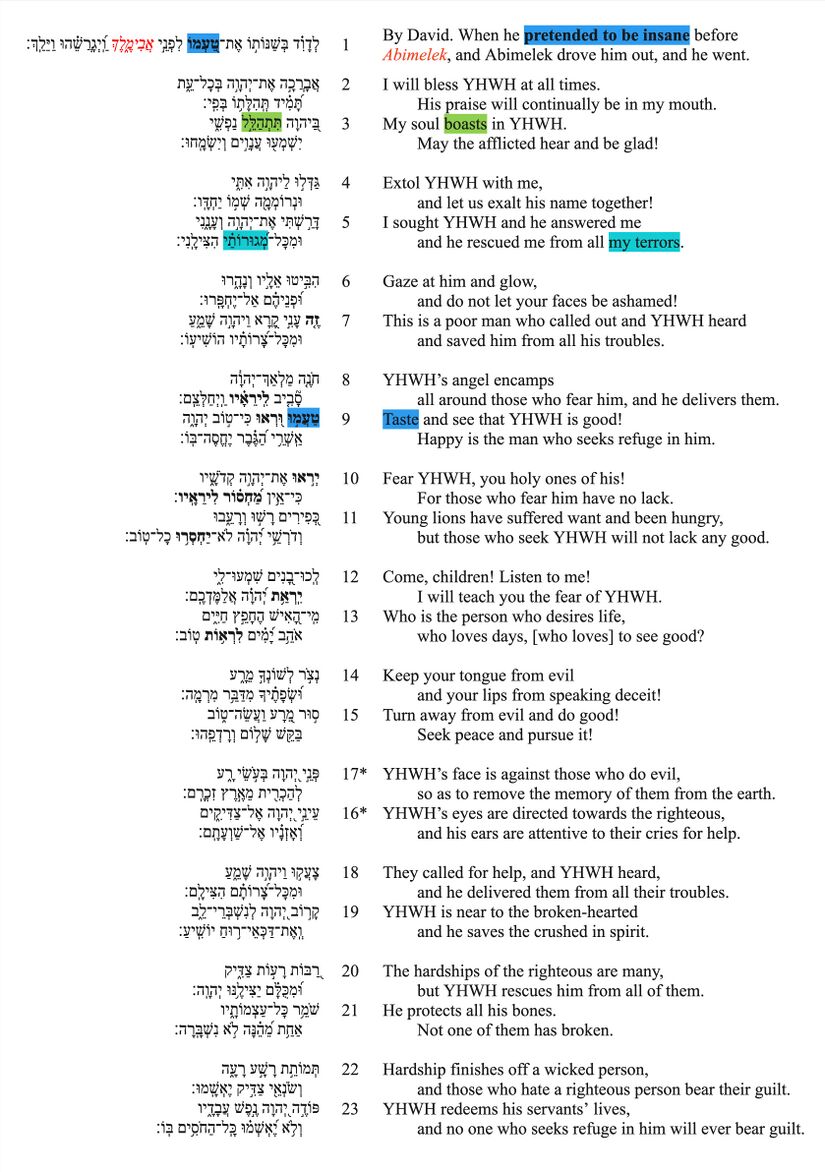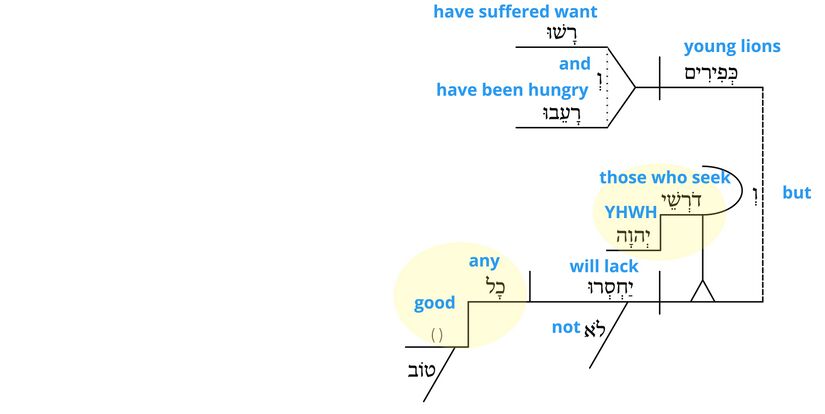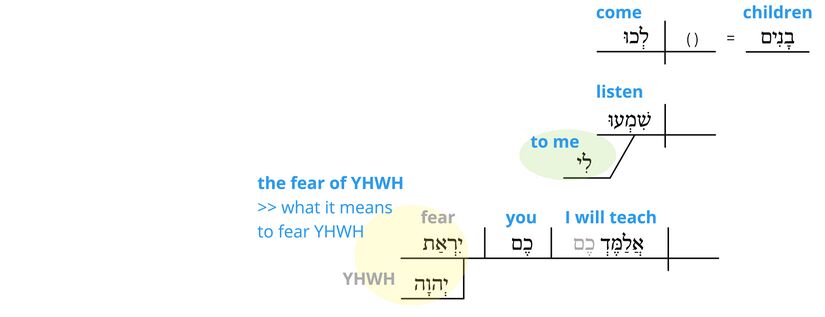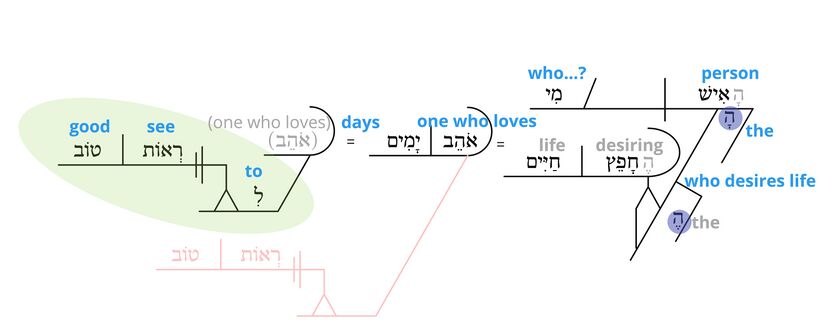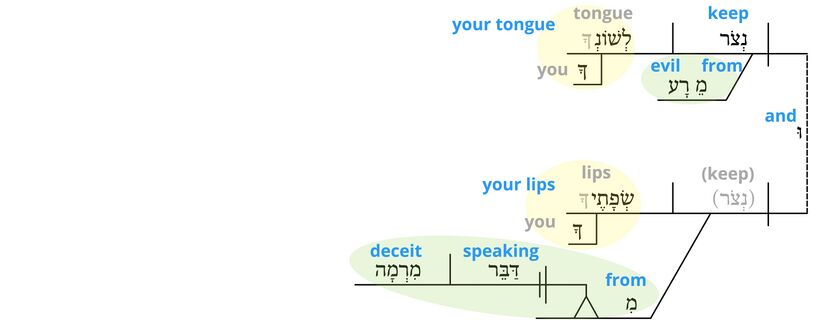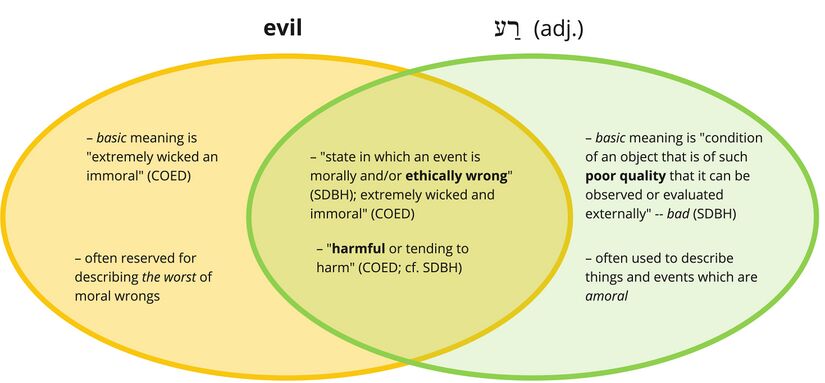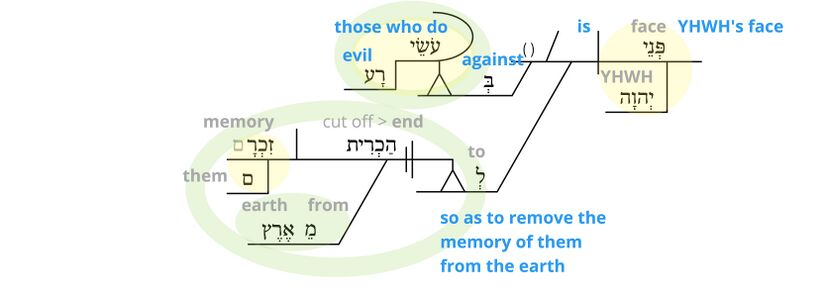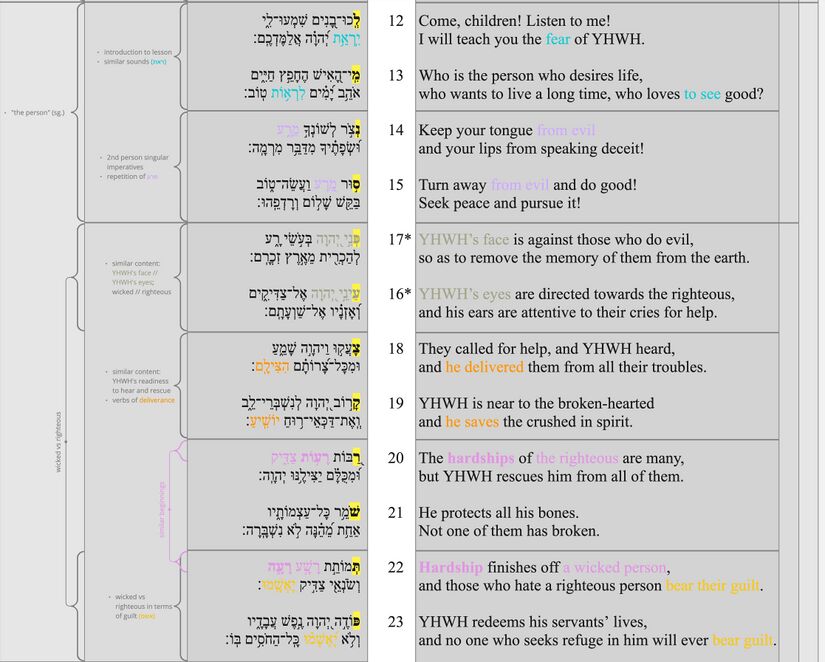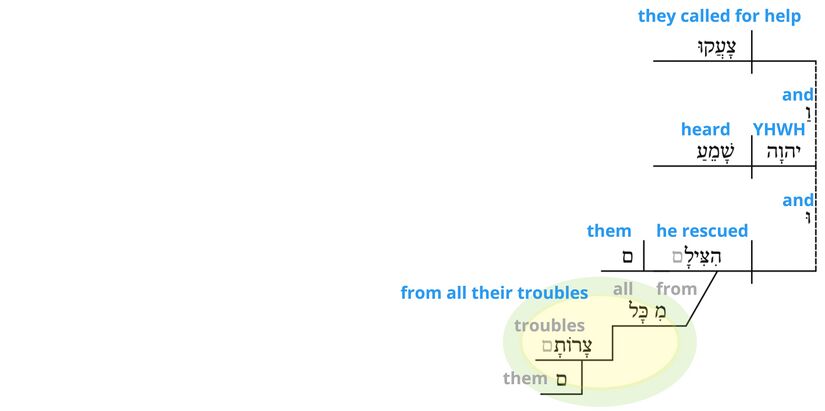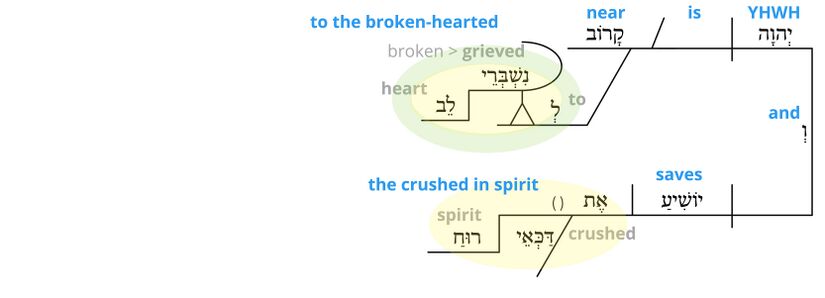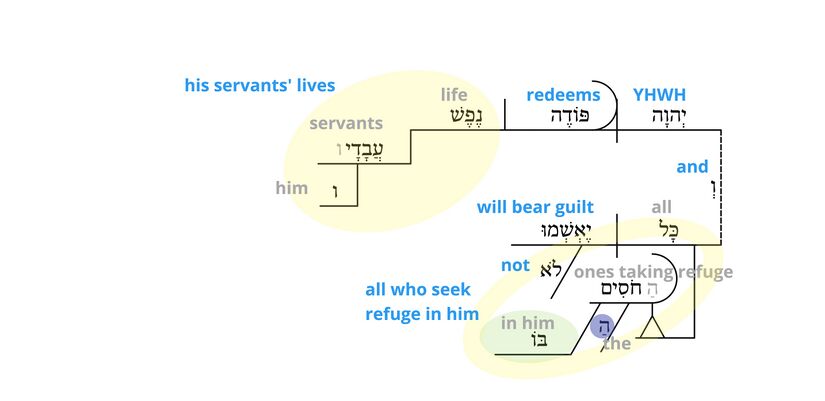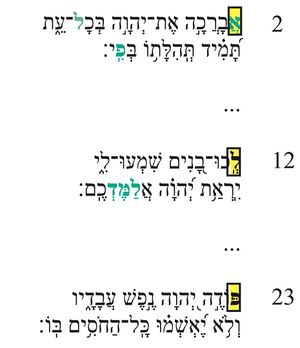Psalm 34 Verse-by-Verse
Welcome to the Verse-by-Verse Notes for Psalm 34!
The Verse-by-Verse Notes present scholarly, exegetical materials (from all layers of analysis) in a verse-by-verse format. They often present alternative interpretive options and justification for a preferred interpretation. The Verse-by-Verse Notes are aimed at consultant-level users.
The discussion of each verse of this psalm includes the following items.
- A link to the part of the overview video where the verse in question is discussed.
- The verse in Hebrew and English.[1]
- An expanded paraphrase of the verse.[2]
- A grammatical diagram of the verse, which includes glosses for each word and phrase.[3]
- A series of notes on the verse, which contain information pertaining to the interpretation of the psalm (e.g., meaning of words and phrases, poetic features, difficult grammatical constructions, etc.).
v. 1
Watch the Overview video on v. 1.
| v. | Hebrew | Close-but-clear |
|---|---|---|
| 1 | לְדָוִ֗ד בְּשַׁנּוֹת֣וֹ אֶת־טַ֭עְמוֹ לִפְנֵ֣י אֲבִימֶ֑לֶךְ וַֽ֝יְגָרֲשֵׁ֗הוּ וַיֵּלַֽךְ׃ | By David. When he pretended to be insane before Abimelech, and Abimelech drove him out, and he went. |
Expanded Paraphrase
This song was written by David. He wrote it as he reflected on the time when he fled to the Philistine city of Gath and was recognized as the famous warrior of Judah who had slain Goliath of Gath and was arrested by the servants of Abimelek the king of Gath. David was afraid for his life, and in an attempt to escape, he pretended to be insane before Abimelek, and Abimelek falling for the trick and not wishing to have insane people around him drove him (David) out of his presence, and he (David) went safely away from Gath and hid in the cave of Adullam where many afflicted people joined him. David said to them
Grammatical Diagram
Notes
- Ps. 34 is one of thirteen psalms in the Psalter that begin with a historical note. See Historical Superscriptions. The story referred to in this superscription is found in 1 Sam. 21:11-22:1. This story might be visualised as follows:
- When he pretended...: "The preposition בְּ + infinitive construct often refers to events that provide the temporal frame of an event or events referred to in a subsequent sentence" (BHRG 39.6). This construction (בְּ + infinitive construct) is standard for the historical superscriptions in the Psalter (Pss. 3; 34; 51; 52; 54; 56; 57; 59; 60; 63; 142) and occurs in other poems outside the Psalter (e.g., Isa. 38:9).
- The phrase translated when he pretended to be insane (cf. 1 Sam. 21:24) might be translated more literally as "when he distorted his taste." "Taste" (cf. v. 9 of the psalm) is here used in the sense of "discernment."[4] The clearest illustration of the meaning of this word in the sense of "discernment" is the story of Abigail, which concludes with David saying, "blessed is your taste > discernment (1 Sam. 25:33). If טַעְמוֹ means "his discernment", then the meaning of the piel verb "change/distort" (שנה) (piel), then, may be similar to what we find in Prov. 31:5: "to pervert (שנּה) the rights of the afflicted" (NRSV). David perverted, or distorted, his discernment.[5]
- The first word of the construct chain "before the face of" (לִפְנֵי) functions here as a preposition: before.[6]
- In the narrative in 1 Samuel, the Philistine king is named "Achish," not Abimelech. It seems likely that "Abimelech" was a title for Philistine kings. This is the best explanation for the fact that Philistine kings in the days of Abraham (Gen. 20), Isaac (Gen. 26), and David (Ps. 34:1) are all referred to as "Abimelech," just as, for example, Egyptian kings of various times are all referred to as "Pharaoh." "Abimelech" ("father of a king") is an appropriate title for dynastic kings who would have passed on the crown to their sons. Even so, the author of the Ps. 34 superscription chose to refer to the king by his title, "Abimelech," rather than by his personal name, "Achish," perhaps to draw attention to the parallels between David's experience with "Abimelech" and Abraham and Isaac's experiences with "Abimelech." See The Relationship Between Psalm 34 and its Historical Superscription.
- The wayyiqtol verbs drove out...went continue the semantics of the infinitive construct.[7]
v. 2
Watch the Overview video on v. 2.
| v. | Hebrew | Close-but-clear |
|---|---|---|
| 2a | אֲבָרֲכָ֣ה אֶת־יְהוָ֣ה בְּכָל־עֵ֑ת | I will bless YHWH at all times. |
| 2b | תָּ֝מִ֗יד תְּֽהִלָּת֥וֹ בְּפִֽי׃ | His praise will continually be in my mouth. |
Expanded Paraphrase
YHWH has rescued me! So, in response to what YHWH has done for me I will bless YHWH at all times. YHWH has earned my constant admiration and appreciation, and so his praise will continually be spoken and sung in my mouth.
Grammatical Diagram
Notes
- Psalm 34 is an acrostic poem; each verse begins with a successive letter of the Hebrew alphabet (cf. Pss. 9-10; 25; 37; 111; 112; 119; 145). Just as there are 22 letters in the alphabet, so there are 22 verses in the psalm — 23 if the superscription (v. 1) is included. Thus, v. 2 begins with alef (אֲבָרֲכָה), the first letter of the alphabet. Furthermore, the first, middle, and final consonant of v. 2 (excluding matres lectionis) together spell out אלפ, the name of the first letter of the alphabet, and a Hebrew word meaning "to teach."[8]
- In the first half of the psalm (vv. 2-11), the emotions are positive and high-energy. In this first half of the psalm, the psalmist exudes with joy and confidence as he gives his testimony and exhorts others to experience what he experienced.
- David resolves to bless YHWH (אֲבָרֲכָה אֶת־יְהוָה). The cohortative form (אֲבָרֲכָה) is used to "express the will or strong desire of the speaker."[9] To "bless the Lord" means "to declare God to be the source of the special power = to praise God" (HALOT). The appropriate response to YHWH's deliverance is to bless/praise him (cf. Ps. 103).
- He resolves to bless YHWH at all times (so ESV, NIV, NLT, NET), or "at every moment." This prepositional phrase, along with the adverb continually in the following clause, gives a continuous sense to the action of blessing/praising. The meaning is hyperbolic (cf. GNT: "I will always thank the LORD; I will never stop praising him").
- The clause His praise will continually be in my mouth is declarative—in Hebrew, it is a verbless clause (תָּ֝מִ֗יד תְּֽהִלָּת֥וֹ בְּפִֽי). Following the cohortative (אֲבָרֲכָה) in the first half of the verse, which has a commissive function, this clause is probably also commissive. The psalmist is committing himself to praising YHWH (not just occasionally, but) continually.
- To have YHWH's praise in one's mouth is to say "my mouth will... praise him" (NET),[10] or "I will praise him with my mouth."
- Praise is an "action by which humans express their appreciation, admiration, respect, and/or gratitude to deities about who they are and what they do."[11]
- The adverb continually (תָּמִיד) is fronted, probably for verum focus; the psalmist is confirming what he has said in the a-line ("at all times"). At the same time, the fronting of תָּמִיד results in a chiastic structure: (a) I will bless YHWH (b) at all times, (b') continually (a') his praise will be in my mouth.
v. 3
Watch the Overview video on v. 3.
| v. | Hebrew | Close-but-clear |
|---|---|---|
| 3a | בַּ֭יהוָה תִּתְהַלֵּ֣ל נַפְשִׁ֑י | My soul boasts in YHWH. |
| 3b | יִשְׁמְע֖וּ עֲנָוִ֣ים וְיִשְׂמָֽחוּ׃ | May the afflicted hear and be glad! |
Expanded Paraphrase
My soul boasts not in myself, but in YHWH because I did not save myself. Rather, YHWH is the one who rescued me. May the afflicted hear about what YHWH did for me and be glad because, if YHWH can rescue me, an afflicted person, then he can rescue other afflicted people, too!
Grammatical Diagram
Notes
- The prepositional phrase in YHWH (בַּיהוָה) is fronted, and this fronting has two effects: (1) the second verse of the poem begins with beth and thus fits the acrostic structure; (2) the fronted constituent "in YHWH" (בַּיהוָה) is focussed:[12] "It is in YHWH (and not in myself or in any other) that my soul will boast." To boast "in YHWH" is to boast "because of YHWH."[13]
- The word boasts sounds like the word for "act insane" which appears in the story of 1 Sam. 21:14 (וַיִּתְהֹלֵל בְּיָדָם). This is one of several allusions within the psalm to the story behind the psalm that is mentioned in the superscription. (See the visual in the notes on v. 9.)
- The second line in this verse mentions the afflicted. To be "afflicted" is a "state of persons who are suffering and unable to help themselves ◄ because of their own need or status, or the result of someone else's behavior ≈ often used positively of persons who are sincere and not arrogant in their behavior" (SDBH). Following the superscription in v. 1, we are perhaps meant to think of the four hundred afflicted people who came to join David in the cave of Adullam after David he left Gath (cf. 1 Sam. 22:2).
- The yiqtol verbs are probably jussives: May the afflicted hear and be glad! (cf. NIV, NLT, ESV, NET, GNT, CEV).[14]
v. 4
Watch the Overview video on v. 4.
| v. | Hebrew | Close-but-clear |
|---|---|---|
| 4a | גַּדְּל֣וּ לַיהוָ֣ה אִתִּ֑י | Extol YHWH with me, |
| 4b | וּנְרוֹמְמָ֖ה שְׁמ֣וֹ יַחְדָּֽו׃ | and let us exalt his name together! |
Expanded Paraphrase
Extol YHWH with me , all you afflicted people, because YHWH is great, and let us exalt his name together!
Grammatical Diagram
Notes
- To extol YHWH (גדל) is to acknowledge that he is "great" (גדול).
- The lamed prepositional phrase YHWH (לַיהוָה) is used here, as elsewhere, to indicate the one who receives praise.[15]
- The cohortative let us exalt is used to encourage the afflicted to join David in exalting YHWH.[16]
- To exalt someone's name is an "action by which humans acknowledge the elevated status of deities and give expression to that."[17]
v. 5
Watch the Overview video on v. 5.
| v. | Hebrew | Close-but-clear |
|---|---|---|
| 5a | דָּרַ֣שְׁתִּי אֶת־יְהוָ֣ה וְעָנָ֑נִי | I sought YHWH and he answered me |
| 5b | וּמִכָּל־מְ֝גוּרוֹתַ֗י הִצִּילָֽנִי׃ | and he rescued me from all my terrors. |
Expanded Paraphrase
I myself was afflicted. I was afraid for my life, and I did not know what to do. But then I sought YHWH to see what I should do and he answered me and gave me the idea and the ability to pretend to be insane before Abimelek and he made the attempt successful, so that Abimelek drove me out and thus he (YHWH) rescued me from all my terrors.
Grammatical Diagram
Notes
- This mini-narrative (I sought... he answered... he rescued) refers to past events named in the superscription (v. 1). Apparently, when David became afraid in Gath, he sought YHWH for guidance.[18]
- "Seeking" is an "action where humans make an intensive effort to associate with a deity, to serve and worship him, and to get answers to questions."[19] It can refer to "an inquiry after knowledge, advice, insight, into a particular problem (Gen. 25:22). Such inquiry could be made through a prophet, i.e. a divine spokesman (Ex. 7:1; Ex. 18:15ff; 1 Sam. 9:9; Jer. 21:2 etc.), or through a priest using 'lots' (Deut. 17:9)."[20]
- The weqatal form in the second clause and he answered (וְעָנָנִי) probably indicates result: "I sought YHWH, and (as a result) he answered me."[21]
- The phrase and from all my terrors (וּמִכָּל־מְגוּרוֹתַי) is fronted, probably for marked focus: "YHWH saved me from (not just some, but) all of my terrors."[22]
- The word for terrors (מְגֹורָה) occurs elsewhere only in Prov. 10:24 and Isa. 66:4,[23] and it refers not to "fear" or "terror" in the abstract, but to some "thing dreaded" (BDB), "object of dread, horror" (HALOT), "(object of) fear, dread" (DCH). The word also sounds like the word for "sojourning" and may thus allude to David's sojourn in Gath (v. 1).[24]
v. 6
Watch the Overview video on v. 6.
| v. | Hebrew | Close-but-clear |
|---|---|---|
| 6a | *הַבִּיטוּ* אֵלָ֣יו *וּנְהָרוּ* | Gaze at him and glow, |
| 6b | וּפְנֵיכֶם* אַל־יֶחְפָּֽרוּ׃* | and do not let your faces be ashamed! |
* Asterisks indicate textual issues where the CBC does not follow the MT, with details below.
Expanded Paraphrase
When you are in a similar situation, afflicted like I was, gaze at him (YHWH) with confident expectation and you will glow with joy, because he will answer your prayer and you will not be disappointed, and do not seek help from elsewhere and so let your faces be ashamed!
Grammatical Diagram
Notes
- There is a textual problem in this verse. For a detailed discussion, see The Text of Psalm 34:6. In short, the MT translates "They looked... and were lightened: and their faces..." (KJV) (הִבִּיטוּ אֵלָיו וְנָהָרוּ).[25] By contrast, some modern translations (RSV, NRSV, CEV, NJB, NEB, GNB) have imperatives in the a-line ("look to him and be radiant!") and a 2mp suffix in the b-line ("your faces"). The latter option has the support of most of the ancient versions[26] and fits better within the syntactic context of v. 6 (jussive in the b-line), the wider semantic context of the first half of the psalm (vv. 2-11), and the psalm's historical background (v. 1; cf. 1 Sam. 21).
- To gaze at YHWH means looking to him with confidence.[27]
- The verb glow (נהר) occurs elsewhere only in Isa. 60:5 (and perhaps also in Jer. 31:12), but most lexicons and translations agree that it means "to be radiant (with joy)."[28] "Glowing" implies joyful amazement.[29]
- The subject your faces (פְנֵיכֶם) is fronted before the verb and before the negative particle (אל), probably for poetic reasons.[30] The current order strengthens the phonological (chiastic) correspondence between "Gaze at him" (הַבִּיטוּ אֵלָיו) and "let not be ashamed" (אַל־יֶחְפָּרוּ): (a) "Gaze" (הַבִּיטוּ) (b) "at him" (אֵלָיו) (c) "and glow", (d) "and your faces" (b') "may they not" (אַל) (a') "be ashamed" (יֶחְפָּרוּ). Note the correspondence between אֵלָיו and אַל and between הבּ and הפּ.[31]
v. 7
Watch the Overview video on v. 7.
| v. | Hebrew | Close-but-clear |
|---|---|---|
| 7a | זֶ֤ה עָנִ֣י קָ֭רָא וַיהוָ֣ה שָׁמֵ֑עַ | This is a poor man who called out and YHWH heard |
| 7b | וּמִכָּל־צָ֝רוֹתָ֗יו הוֹשִׁיעֽוֹ׃ | and saved him from all his troubles. |
Expanded Paraphrase
This —I am referring to myself— is a poor and afflicted man who called out to YHWH for help and YHWH heard him and saved him from all his troubles. If YHWH saved me, then he can save you too, if you call out to him amidst your troubles.
Grammatical Diagram
Notes
- Although waw is the sixth letter in the Hebrew alphabet, the sixth verse of the acrostic poem begins with the seventh letter of the alphabet, zayin. The omission of a waw verse is probably deliberate on the part of the poet.[32] The waw verse is missing also in Ps. 25, and possibly also in the Qumran poem known as 'Apostrophe to Zion.'[33]
- This is a poor man who called out. The syntax of v. 7aα is disputed. Most English translations read "this" (זֶה) as an adjective modifying "poor man": “this poor man.”[34] It is more likely, however, that "this" (זֶה) is the subject, "poor man" is the predicate complement, and "called out" (קָרָא) is a relative clause: "this is a poor man who called out."[35]
- In the second clause of v. 7a, the subject YHWH is fronted, probably because the clause is thetic: "This is a poor man who called out, and (do you know what happened next?) YHWH answered."
- The sequence of this mini-narrative (called out... heard... saved) is essentially the same as the one in v. 5.
- The phrase from all his troubles (מִכָּל־צָרוֹתָיו) is fronted for marked focus: YHWH rescued him (not from some, but) from all his troubles (cf. v. 5b).
v. 8
Watch the Overview video on v. 8.
| v. | Hebrew | Close-but-clear |
|---|---|---|
| 8a[36] | חֹנֶ֤ה מַלְאַךְ־יְהוָ֓ה | YHWH’s angel encamps |
| 8b | סָ֘בִ֤יב לִֽירֵאָ֗יו וַֽיְחַלְּצֵֽם׃ | all around those who fear him, and he delivers them. |
Expanded Paraphrase
Whenever YHWH's people are surrounded by enemies YHWH’s angel encamps all around those who fear him to guard them on every side and when the enemies try to attack he delivers them (those who fear YHWH) so that they are safe from all harm.
Grammatical Diagram
Notes
- Verse 8 marks the beginning of a new subsection within the first half of the psalm. Whereas, in vv. 2-7, David repeatedly refers to himself and gives his personal testimony of YHWH's deliverance, in vv. 8-11, David does not refer to himself but speaks more generally of "those who fear YHWH" (יראיו), a phrase which is repeated verbatim in v. 8 and v. 10 and echoed with sound plays in vv. 9-10.
- Most English translations rightly render the verbs in this verse with present tense verbs: encamps... and delivers (NIV, ESV, KJV, cf. NET, GNT).[37] The author might have used a participle (חנה) instead of a yiqtol (יחנה), because a yiqtol would not have fit the acrostic. The acrostic structure might also explain why חֹנֶה is fronted.[38]
- The verb encamps refers to an "action by which an individual or group of people settles in a certain location for a limited period of time and often for a specific purpose."[39] Here, the "specific purpose" is to guard those who fear him; the encampment is a military encampment.[40] So NLT: "For the angel of the LORD is a guard; he surrounds and defends all who fear him"; GNT: "His angel guards those who honor the LORD and rescues them from danger."
- The precise identity of YHWH's angel is debated. "YHWH's angel" might be identified with YHWH himself,[41] or he might be distinguished from YHWH as the messenger whom YHWH sends, who represents YHWH.[42] YHWH's angel is here depicted as a warrior, as e.g., in Joshua 5:14. See also the following psalm (Ps. 35), which mentions YHWH's angel.[43]
v. 9
Watch the Overview video on v. 9
| v. | Hebrew | Close-but-clear |
|---|---|---|
| 9a | טַעֲמ֣וּ וּ֭רְאוּ כִּי־ט֣וֹב יְהוָ֑ה | Taste and see that YHWH is good! |
| 9b | אַֽשְׁרֵ֥י הַ֝גֶּ֗בֶר יֶחֱסֶה־בּֽוֹ׃ | Happy is the man who seeks refuge in him. |
Expanded Paraphrase
YHWH delivers his people, because YHWH is good. Call out to him for deliverance, and so taste and see for yourself that YHWH is good! Happy is the man who seeks refuge in him.
Grammatical Diagram
Notes
- The CEV nicely captures the meaning of the first two verbs taste and see with the translation, "Discover for yourself."
- The subordinate clause introduced by that (כי) complements both verbs.[44]
- In this subordinate clause, the predicate complement good (טוב) is fronted, probably for predicate focus. A person "tastes" (טעם) something to discover its quality (i.e., to find out whether it is good or bad). The question, then, is: how is YHWH? Is he good or bad? The psalmist says that YHWH is good.
- The word taste (טַעֲמוּ) is nearly identical to the word "taste > discernment" (טַעְמוֹ) in the superscription (v. 1).[45] This is one of several allusions within the psalm to the story referred to in its superscription. Note also the word "boasts" in v. 3, which sounds like the word for "pretend to be mad" in 1 Samuel 21, and the word "terrors", which sounds like the word for "sojourning."
- The phrase happy is the man (אַשְׁרֵי הַגֶּבֶר) is, in Hebrew, a sentence fragment expressing admiration and congratulations. See notes on Ps. 1:1.
v. 10
Watch the Overview video on v. 10.
| v. | Hebrew | Close-but-clear |
|---|---|---|
| 10a | יְר֣אוּ אֶת־יְהוָ֣ה קְדֹשָׁ֑יו | Fear YHWH, you holy ones of his! |
| 10b | כִּי־אֵ֥ין מַ֝חְס֗וֹר לִירֵאָֽיו׃ | For those who fear him have no lack. |
Expanded Paraphrase
Fear YHWH, you holy ones of his who belong to him and are devoted to his service! For those who fear him have no lack. Therefore, if you fear YHWH, he will provide for you, and you will not lack.
Grammatical Diagram
Notes
- The word fear represents a key concept in this psalm; words from the ירא word-group occur four times in vv. 8–12.
- The vocative holy ones occurs at the end of the clause, which leaves the focal nature of the imperative in no doubt.[46] The position of the vocative may also be affected by the acrostic structure.
- To be holy is to be "in the service of God and therefore set apart from other people" (SDBH); "The basic meaning of the word is “consecrated” or “devoted.” In Scripture it operates within the context of covenant relationships and expresses commitment."[47] YHWH's holy ones thus refers to "all you who belong to him."[48]
- The For (כי) clause in v. 10b provides the grounds of the exhortation in v. 10a: "the reason why you should fear YHWH is because those who fear YHWH have no lack."[49]
- The Hebrew construction "there is no lack for those who fear him" (אֵין מַחְסוֹר לִירֵאָיו) is more naturally rendered "those who fear him have no lack" (ESV).[50]
v. 11
Watch the Overview video on v. 11.
| v. | Hebrew | Close-but-clear |
|---|---|---|
| 11a | כְּ֭פִירִים רָשׁ֣וּ וְרָעֵ֑בוּ | Young lions have suffered want and been hungry, |
| 11b | וְדֹרְשֵׁ֥י יְ֝הוָ֗ה לֹא־יַחְסְר֥וּ כָל־טֽוֹב׃ | but those who seek YHWH will not lack any good. |
Expanded Paraphrase
Even young lions who, being fierce hunters are the least likely of all creatures to go hungry have suffered want and been hungry, but those who seek YHWH and do not, like lions, rely on their own power to meet their needs will not lack any good.
Grammatical Diagram
Notes
- This verse contrasts "those who seek YHWH" with "young lions." The contrast is reinforced by the word order: the subject in v. 11a ("young lions", כְּפִירִים) and the subject in v. 11b ("those who seek YHWH" דֹרְשֵׁי יְהוָה) are both fronted as contrasting topics:[51] "As for young lions... as for those who seek YHWH..."
- Young lions are mentioned because they are the least likely of all creatures to go hungry.[52] Young lions are also a metaphor for those who don't fear YHWH.[53]
- The qatal verbs (have suffered want and been hungry) are probably past tense.[54] The psalmist is reporting some past observation which has timeless implications.[55] "Lions have been reduced to starvation, but those who turn to the LORD shall not lack any good" (JPS1985) >> "Even strong young lions sometimes go hungry, but those who trust in the LORD will lack no good thing" (NLT; cf. NET, GNT, NGÜ, GNB).
- Verse 11, especially v. 11b, is relatively long (11b: 6 words, 21 letters, 12 syllables), and it functions to draw the first major section of the psalm (vv. 2–11) to a close.[56]
v. 12
Watch the Overview video on v. 12.
| v. | Hebrew | Close-but-clear |
|---|---|---|
| 12a | לְֽכוּ־בָ֭נִים שִׁמְעוּ־לִ֑י | Come, children! Listen to me! |
| 12b | יִֽרְאַ֥ת יְ֝הוָ֗ה אֲלַמֶּדְכֶֽם׃ | I will teach you the fear of YHWH. |
Expanded Paraphrase
Come, you who are my students and so are like my children! Listen to me! I will teach you the fear of YHWH.
Grammatical Diagram
Notes
- The lamed verse begins the second half of the psalm (vv. 2-11 // vv. 12-23).[57] The new section is marked by the imperatives and the vocative in v. 12a, and the introduction of the new topic of the discourse in v. 12b: the fear of YHWH. The division of Psalm 34 into two parts is also supported by an ancient tradition that reads סלה at the end of v. 11.[58]
- In the second half of the psalm (vv. 12-23), the emotional tone is still positive, but it is less active. The excitement of the testimony (vv. 2-11) gives way to a more composed and serious posture for teaching (vv. 12-23).
- The word children is a "title used to address a person (male if in singular) who is regarded with some degree of affection... as if he were the speaker's child" (SDBH). "The sense is not precisely children, but pupils or students, the Hebrew word being the conventional form of address employed by the wise men (viz. teachers) toward the members of their class (cf. Prov. 4:1)."[59] "The use of a kinship term as a vocative implies that speaker and addressee have a close and friendly relationship, equivalent to the ideal form of the family relationship named (parent, child, or sibling). Where there is no blood relationship, a kinship term is typically used in address where the speaker is trying to persuade the addressee to some course of action."[60]
- The word teach (אֲלַמֶּדְכֶם) might be a play on the name of the letter lamed.[61] This is, therefore, the second time in which the poet has played with a word meaning "to teach" (cf. אלף in v. 1). These references to teaching might hint at the purpose of the psalm as a whole: to teach.
- The phrase the fear of YHWH (יִרְאַת יְהוָה) is fronted in v. 12b for marked focus.[62]The previous imperatives ("Come...! Listen to me!") and the labelling of the addressee as "children" (> students) raises the expectation that something is about to be taught. With a marked-focus construction, David specifies in the next line what is going to teach them: the fear of YHWH.
- The phrase "the fear of YHWH" (NEB, NIV, ESV) might be more clearly translated "what it means to fear YHWH" (NET, cf. HFA, NGÜ). The rest of the psalm (vv. 12-23) draws out what it means to fear YHWH.
v. 13
Watch the Overview video on v. 13.
| v. | Hebrew | Close-but-clear |
|---|---|---|
| 13a | מִֽי־הָ֭אִישׁ הֶחָפֵ֣ץ חַיִּ֑ים | Who is the person who desires life, |
| 13b | אֹהֵ֥ב יָ֝מִ֗ים לִרְא֥וֹת טֽוֹב׃ | who loves days, [who loves] to see good? |
Expanded Paraphrase
Who among you is the person who desires life, who wants to live a long time, who loves to see good? Surely, each of you desires a long life full of good for this is widely regarded as a tremendous blessing.
Grammatical Diagram
Notes
- Who is the person who desires life, who loves days, [who loves] to see good? The NET does an excellent job of translating the pragmatic force of this question into English: "Do you want to really live? Would you love to live a long, happy life?" (NET). As they, note, "The rhetorical question is used to grab the audience’s attention." The technique is similar to that used today in advertisements (e.g., "Do you want to make more money?" "Do you want to lose twenty pounds in a week?" "Are you tired of X?"). When Peter quotes this verse in the NT (1 Pet. 3:10-11), he changes the form but maintains the pragmatic force: “Whoever would love life (ὁ γὰρ θέλων ζωὴν ἀγαπᾶν)... let him restrain (παυσάτω)... let him turn from (ἐκκλινάτω)... let him seek (ζητησάτω)."
- The syntax of to see good (לִרְאוֹת טוֹב) is difficult. Most modern translation read this infinitival clause as a purpose clause: "...loves many days, that he may see good?" (ESV) >> "...desires a long life to enjoy all good things" (NEB).[63] It is also possible, however, that the participle "one who loves" (אֹהֵב) is elided in this last phrase: "[who loves] to see good." Given the fact that the verb אהב sometimes take a lamed infinitive construct as its complement, this latter option seems likely.[64]
- The person (הָאִיש) is definite; the description of this person is expanded upon in the rest of the interrogative, and so "the person" is identifiable by the context: Which person? The one who desires life, etc.
- Lengthening one's days (i.e., living a long time) and seeing "good" was regarded as a tremendous blessing.[65]
v. 14
Watch the Overview video on v. 14.
| v. | Hebrew | Close-but-clear |
|---|---|---|
| 14a | נְצֹ֣ר לְשׁוֹנְךָ֣ מֵרָ֑ע | Keep your tongue from evil |
| 14b | וּ֝שְׂפָתֶ֗יךָ מִדַּבֵּ֥ר מִרְמָֽה׃ | and your lips from speaking deceit! |
Expanded Paraphrase
If you are such a person, then here's what you must do: Keep your tongue from speaking evil and your lips from speaking deceit!
Grammatical Diagram
Notes
- The psalmist addresses "the person" (v. 13) directly, teaching him what he must do if he wants to live a long and happy life. When Peter quotes this verse in the NT (1 Pet. 3:10-11), he changes the form but maintains the pragmatic force: “Whoever would love life (ὁ γὰρ θέλων ζωὴν ἀγαπᾶν)... let him restrain (παυσάτω)... let him turn from (ἐκκλινάτω)... let him seek (ζητησάτω)."
v. 15
Watch the Overview video on v. 15.
| v. | Hebrew | Close-but-clear |
|---|---|---|
| 15a | ס֣וּר מֵ֭רָע וַעֲשֵׂה־ט֑וֹב | Turn away from evil and do good! |
| 15b | בַּקֵּ֖שׁ שָׁל֣וֹם וְרָדְפֵֽהוּ׃ | Seek peace and pursue it! |
Expanded Paraphrase
Turn away from evil and do good! Seek peace and pursue it! This is what it means, practically, to fear YHWH, and those who fear YHWH will live long and happy lives, because YHWH protects and provides for those who fear him.
Grammatical Diagram
Notes
v. 17*
Watch the Overview video on v. 17.
| v. | Hebrew | Close-but-clear |
|---|---|---|
| 17a | פְּנֵ֣י יְ֭הוָה בְּעֹ֣שֵׂי רָ֑ע | YHWH’s face is against those who do evil, |
| 17b | לְהַכְרִ֖ית מֵאֶ֣רֶץ זִכְרָֽם׃ | so as to remove the memory of them from the earth. |
Expanded Paraphrase
By contrast, YHWH’s face is against those who do evil, so as to remove the memory of them from the earth so that those who do evil will never be remembered.
Grammatical Diagram
Notes
- In the original text of Ps. 34, the pe verse (v. 17) probably preceded the ayin verse. See The Text and Meaning of Psalm 34:18 for a detailed discussion of the issue. In short, the pe-ayin sequence of the alphabet is attested in Lamentations 2-4, LXX Proverbs 31, and in every pre-exilic Hebrew abecedary discovered to date. If this arrangement is posited for Psalm 34, then the difficulty of the ambiguous subject in v. 18a disappears entirely and the text flows much more naturally.
- Verses 17-23 begin a new subsection within the second half of the psalm. Whereas vv. 12-15 introduce the topic of the discourse and focus in on a hypothetical individual (האיש) who wants to live a long and happy life, vv. 17-23 are about YHWH's provision for and protection of the righteous in contrast to the wicked. These verses use only indicative verbs (in contrast to the imperatives in vv. 12-15). The subsection is bound by an inclusio; it begins (v. 17) and ends (v. 23) with a clear contrast between the righteous and the wicked.
- YHWH's face is against those who do evil. Other passages speak of YHWH putting (נתן / שים) his face "against" (בְּ) someone, often with the intention of "cutting them off>destroying them" (e.g., Lev. 17:10; 20:3, 5, 6; 26:17; Jer. 21:10; 44:11; Ezek. 14:8; 15:7).
v. 16*
Watch the Overview video on v. 16.
| v. | Hebrew | Close-but-clear |
|---|---|---|
| 16a | עֵינֵ֣י יְ֭הוָה אֶל־צַדִּיקִ֑ים | YHWH’s eyes are directed towards the righteous, |
| 16b | וְ֝אָזְנָ֗יו אֶל־שַׁוְעָתָֽם׃ | and his ears are attentive to their cries for help. |
Expanded Paraphrase
YHWH’s eyes are directed towards the righteous so that he sees them in their distress, and his ears are attentive to their cries for help so that he hears them when they cry out to him.
Grammatical Diagram
Notes
- The prepositional phrase toward the righteous (ESV) indicates the "goal of movement of a process.[66] In English, it would be more natural to say "on the righteous" (NIV), or perhaps even "the eyes of YHWH watch over those who do right" (NLT).
v. 18
Watch the Overview video on v. 18.
| v. | Hebrew | Close-but-clear |
|---|---|---|
| 18a | צָעֲק֣וּ וַיהוָ֣ה שָׁמֵ֑עַ | They called for help, and YHWH heard, |
| 18b | וּמִכָּל־צָ֝רוֹתָ֗ם הִצִּילָֽם׃ | and he delivered them from all their troubles. |
Expanded Paraphrase
Here is something that I have seen in the past, and it is typical of what happens again and again: When the righteous experienced trouble they called for help, and YHWH heard them, and he delivered them from all their troubles.
Grammatical Diagram
Notes
- If v. 18 follows v. 17, then the subject of called out is difficult to determine. If, however, v. 18 follows v. 16, then the subject is unambiguously "the righteous." See The Text and Meaning of Psalm 34:18.
- Most modern translations render the verbs called...heard...delivered as timeless (KJV, NIV, NLT, ESV, NET, GNT, CEV, JPS85, LUT, HFA, NGÜ, ELB, GNB, ZÜR), which might be a good functional equivalent. In Hebrew, however, the verbs are past tense forms (qatals), as the ancient translators recognized.[67] The sequence of past tense forms create a mini-narrative which has a proverbial character (cf. e.g., Prov. 11:2, 8). Proverbs are often past tense because they report some past experience or observation which has timeless implications.[68]
- The language of v. 18 clearly echoes that of v. 7. This connection is part of a larger symmetrical structure in which vv. 17-23 parallel vv. 2-8 and vv. 12-15 parallel vv. 8-11.
v. 19
Watch the Overview video on v. 19.
| v. | Hebrew | Close-but-clear |
|---|---|---|
| 19a | קָר֣וֹב יְ֭הוָה לְנִשְׁבְּרֵי־לֵ֑ב | YHWH is near to the broken-hearted |
| 19b | וְֽאֶת־דַּכְּאֵי־ר֥וּחַ יוֹשִֽׁיעַ׃ | and he saves the crushed in spirit. |
Expanded Paraphrase
YHWH delivers the righteous, who are afflicted, because YHWH is near to the broken-hearted and thus he is able to hear them when they call out for help and he saves the crushed in spirit.
Grammatical Diagram
Notes
- The predicate complement near is fronted (קָרוֹב),[69] probably so that the verse begins with qof, according to the acrostic pattern.
- To be near someone in Hebrew means to be able and ready to hear them when they call out (cf. Deut. 4:7; Ps. 145:18; Isa. 55:6).
- The broken-hearted (NIV, NLT, ESV, NET; literally "broken of heart >> broken with respect to the heart") are those who are "discouraged" (CEV, GNT; cf. NEB), who suffer emotional pain (DCH) because of oppression (HALOT).[70] The phrase is similar to the phrase "poor in spirit" in Matthew's gospel (Matt. 5:3).
- In the second line, the direct object the crushed in spirit (אֶת־דַּכְּאֵי־רוּחַ) is fronted, probably for the purpose of poetic binding; the syntax of v. 19 is chiastic: (a) YHWH is near (b) to the broken-hearted, (b') the crushed in spirit (a') he saves.
v. 20
Watch the Overview video on v. 20
| v. | Hebrew | Close-but-clear |
|---|---|---|
| 20a | רַ֭בּוֹת רָע֣וֹת צַדִּ֑יק | The hardships of the righteous are many, |
| 20b | וּ֝מִכֻּלָּ֗ם יַצִּילֶ֥נּוּ יְהוָֽה׃ | but YHWH rescues him from all of them. |
Expanded Paraphrase
The hardships of the righteous are many, but YHWH rescues him from all of them.
Grammatical Diagram
Notes
- The predicate complement many (רַבּוֹת) is fronted. It will not suffice to explain the fronting in terms of the acrostic structure, since the author could have equally achieved a verse beginning with resh by using default word order (רעות צדיק רבות). Instead, רַבּוֹת is probably fronted for predicate focus: "the hardships of the righteous are (not few, but) many."[71]
- As in vv. 5, 7, 18, the phrase from all of them is fronted for marked focus: "YHWH rescues him (not from some of them, but) from all of them."
v. 21
Watch the Overview video on v. 21.
| v. | Hebrew | Close-but-clear |
|---|---|---|
| 21a | שֹׁמֵ֥ר כָּל־עַצְמוֹתָ֑יו | He protects all his bones. |
| 21b | אַחַ֥ת מֵ֝הֵ֗נָּה לֹ֣א נִשְׁבָּֽרָה׃ | Not one of them has broken. |
Expanded Paraphrase
He (YHWH) protects all his (the righteous person's) bones. Not one of them has broken.
Grammatical Diagram
Notes
- The fact that the participle protects (שֹׁמֵר) lacks an explicit subject might suggest that it modifies, or is in apposition to the name "YHWH" in the previous clause.[72] On the other hand, "the personal pronoun which would be expected as the subject of a participial clause is frequently omitted, or at least... the pronoun of the 3rd person הוא."[73] Thus, most translations read v. 21 as an independent clause: "he protects all his bones."[74] As in v. 8, the participle might have been used instead of the yiqtol in order to preserve the acrostic structure.
- "The breaking of the bones was an idiom for divine punishment (Ps 51:8 [10]; Isa 38:13; Lam 3:4). Similarly, God’s protection finds expression in the idiom that bones are not broken (Ps 34:20 [21])" (NIDOTTE).
- It may be that the lion imagery of v. 11 is continued in this verse which mentions broken bones.[75]
- The subject of the clause in the b-line one of them (אַחַת מֵהֵנָּה) is fronted, probably for marked focus.[76] Together with the לא the fronting of אַחַת מֵהֵנָּה creates an absolute negative structure: "not even one single bone is broken." At the same time, the fronting means that the constituents in v. 21 are arranged chiastically: (a) guards (שמר) (b) all his bones, (b') one of them, (a') is not broken (שבר [which sounds like שמר]).
v. 22
Watch the Overview video on v. 22.
| v. | Hebrew | Close-but-clear |
|---|---|---|
| 22a | תְּמוֹתֵ֣ת רָשָׁ֣ע רָעָ֑ה | Hardship finishes off a wicked person, |
| 22b | וְשֹׂנְאֵ֖י צַדִּ֣יק יֶאְשָֽׁמוּ׃ | and those who hate a righteous person bear their guilt. |
Expanded Paraphrase
By contrast, YHWH does not rescue the wicked from hardship. Instead, hardship afflicts and then eventually finishes off a wicked person, and in this way those who hate a righteous person bear their guilt.
Grammatical Diagram
Notes
- The word translated finish off (תְּמוֹתֵת) is a relatively rare word for killing.[77] Several English translations read "slay" (KJV, ESV, NIV), but finish off is more accurate. The word is used to refer to David killing (an already injured) Goliath with a sword (1 Sam. 17:51), Abimelech's armor bearer killing (an already injured) Abimelech with a sword (Jdg. 9:54), the Amalekite killing (an already injured) Saul (with a sword?) (2 Sam. 1:9-10), and Jonathan's armor-bearer killing those whom Jonathan has already injured (1 Sam. 14). In these examples, the patient is already in the process of dying. Thus, the idea in Ps. 34, is that "hardship" (רעה) will plague the wicked, bring him to his knees, and, finally, deliver the death blow to him.[78]
- The word order in v. 22 (the fronting of the object before the subject in the a-line and the fronting of the subject in the b-line) is probably for the purpose of poetic binding:[79] The constituents in v. 22 are arranged in a partial chiasm: (a) Will finish off (verb) (b) the wicked (רָשָׁע—direct object) (c) hardship (subject), (c') but those who hate (subject) (b') a righteous person (צַדִּיק—object of participle) (a') will bear their guilt (verb).
v. 23
Watch the Overview video on v. 23.
| v. | Hebrew | Close-but-clear |
|---|---|---|
| 23a | פּוֹדֶ֣ה יְ֭הוָה נֶ֣פֶשׁ עֲבָדָ֑יו | YHWH redeems his servants’ lives, |
| 23b | וְלֹ֥א יֶ֝אְשְׁמ֗וּ כָּֽל־הַחֹסִ֥ים בּֽוֹ׃ | and no one who seeks refuge in him will ever bear guilt. |
Expanded Paraphrase
Whereas the wicked become guilty of sin, experience hardship as a result of their sin, and then eventually die from their hardships, YHWH forgives, and thereby redeems his servants’ lives from sin, hardship, and death so that they no longer belong to sin, hardship, and death but now belong to him as his servants and so no one who seeks refuge in him will ever bear guilt.
Grammatical Diagram
Notes
- The 'extra' pe verse (v. 23) is perhaps unexpected to most who are familiar with the Hebrew alphabet ending with tav. The feature, which occurs also in the acrostic Psalm 25, is probably deliberate. The addition might be explained as follows: "In the word 'aleph are contained three consonants: the first in the alphabet; the twelfth, lamed, which in the twenty-two letter sequence begins the second half of the alphabet; and the "extra" letter, pe. By going from 'aleph to taw and then adding pe, one makes lamed the exact middle of the series and sums up the whole alphabet in the name of its first letter."[80] Cf. notes on v. 2 and v. 12.
- The participle redeem (פּוֹדֶה) is fronted, probably so that the last verse begins with pe (see notes on v. 8). The context suggests an iterative interpretation of the participle: "YHWH redeems" (cf. KJV, ESV, NET, CEV, NEB).
- To redeem someone/something is "to achieve transfer of ownership from one to another through payment of a price or an equivalent substitute."[81] "Redemption", as a metaphor, can also refer generally to deliverance from danger (cf. 2 Sam. 4:9; 1 Kgs. 1:29). The prototypical act of redemption is narrated in the book of Exodus, when YHWH redeemed Israel from servitude in Egypt to be his servants.[82] Here in Ps. 34, as elsewhere, the image of redemption is applied to redemption from the slavery of sin.[83]
- The connection between redemption and sin becomes clear in the second half of the verse, which says that YHWH's redeemed people will never bear guilt (יֶאְשְׁמוּ). To "bear guilt" means "to bear the consequences for an unlawful deed for which one is held responsible."[84]
Excursus: Genre
In terms of global speech acts, the psalm divides into two parts (vv. 2-11; vv. 12-23).[85] In terms of the genre categories of modern form criticism, the first part (vv. 2–11) is usually described as an individual thanksgiving, and the second part (vv. 12-23) as wisdom teaching.[86] These labels are helpful to an extent but ultimately fall short of accurately and sufficiently describing what the psalm is doing.<rev>Cf. Eriksson 1991, 56–80.</ref>
- vv. 2-11. The first part is usually categorized as an individual thanksgiving. Indeed, Gunkel assigned the whole psalm to this category. There are certainly elements of "thanksgiving" in the first half of the psalm (e.g., resolve to praise YHWH; narrating YHWH's deliverance), but these elements are subordinated to the larger goal of encouraging the afflicted to trust in YHWH. Thus, the first half of the psalm, is filled with exhortations (vv. 3b, 4, 6, 9a), and it is not addressed to YHWH (as in most thanksgiving psalms) but to people.[87]
- vv. 12-23. In the second part of the psalm, the psalmist explicitly describes what he is doing: "I will teach you the fear of YHWH" (v. 12). The verb למד (piel) refers to a "causative action by which humans or deities cause humans or animals -- intentionally or unintentionally -- to acquire knowledge, skill, or behavior; usually refers to learning to the point of doing." The last part of the definition is crucial—"usually refers to learning to the point of doing"—because the psalmist not only wants his audience to understand what it means to fear YHWH but to live accordingly (see esp. the directives in vv. 14-15).
How do the two halves of the psalm relate to one another in terms of the psalmist's overall purpose? Both halves of the psalm share the same perlocution (intended result of the speech act): that others would come to fear YHWH and thereby experience his provision and protection. The first half of the psalm seeks to accomplish this purpose by means of a stirring personal testimony of YHWH's deliverance, intermingled with exhortations to trust in YHWH, and the second half of the psalm seeks to accomplish this by a lesson in what it means to fear YHWH, the goal of which is understanding that leads to doing. To state it another way, the first half of the psalm aims at the emotions, the second half aims at the mind, and both halves aim at the will, so that the reader/hearer might come to fear YHWH and thereby experience YHWH's provision and protection.
Legends
Grammatical diagram
| Visualization | Description |
|---|---|
| The clause is represented by a horizontal line with a vertical line crossing through it, separating the subject and the verb. | |
| The object is indicated by a vertical line that does not cross the horizontal line of the clause. Infinitives and participles may also have objects. If the direct object marker (d.o.m.) is present in the text, it appears in the diagram immediately before the object. If the grammar includes a secondary object, the secondary object will appear after the object, separated by another vertical line that does not cross the horizontal line of the clause. | |
| The subject complement follows the verb (often omitted in Hebrew) separated with a line leaning toward the right. It can be a noun, a whole prepositional phrase or an adjective. The later two appear modifying the complement slot. | |
| When a noun further describes or renames the object, it is an object complement. The object complement follows the object separated by a line leaning toward the right. | |
| In a construct chain, the noun in the absolute form modifies the noun in the construct form. | |
| Participles are indicated in whatever position in the clause they are in with a curved line before the participle. Participles can occur as nominal, where they take the place of a noun, predicate, where they take the place of a verb, or attributive, where they modify a noun or a verb similar to adjectives or adverbs. | |
| Infinitives are indicated by two parallel lines before the infinitive that cross the horizontal line. Infinitive constructs can appear as the verb in an embedded clause. Infinitive absolutes typically appear as an adverbial. | |
| The subject of the infinitive often appears in construct to it. In this situation, the infinitive and subject are diagrammed as a construct chain. | |
| The object of the infinitive is indicated by a vertical line that does not cross the horizontal line of the infinitival clause. | |
| Modifiers are represented by a solid diagonal line from the word they modify. They can attach to verbs, adjectives, or nouns. If modifying a verb or adjective, it is an adverb, but if modifying a noun, it is an adjective, a quantifier, or a definite article. If an adverb is modifying a modifier, it is connected to the modifier by a small dashed horizontal line. | |
| Adverbials are indicated by a dashed diagonal line extending to a horizontal line. These are nouns or infinitives that function adverbially (modifying either a verb or a participle), but are not connected by a preposition. | |
| Prepositional phrases are indicated by a solid diagonal line extending to a horizontal line. The preposition is to the left of the diagonal line and the dependent of the preposition is on the horizontal line. They can modify verbs (adverbial) or nouns (adjectival). | |
| Embedded clauses are indicated by a "stand" that looks like an upside-down Y. The stand rests in the grammatical position that the clause fulfills. Extending from the top of the stand is a horizontal line for the clause. If introduced by a complementizer, for example כִּי, the complementizer appears before the stand. Embedded clauses can stand in the place of any noun. | |
| When clauses are joined by a conjunction, they are compound clauses. These clauses are connected by a vertical dotted line. The conjunction is placed next to the dotted line. | |
| Within a clause, if two or more parts of speech are compound, these are represented by angled lines reaching to the two compound elements connected by a solid vertical line. If a conjunction is used, the conjunction appears to the left of the vertical line. Almost all parts of speech can be compound. | |
| Subordinate clauses are indicated by a dashed line coming from the line dividing the subject from the predicate in the independent clause and leading to the horizontal line of the subordinate clause. The subordinating conjunction appears next to the dashed line. | |
| Relative clauses also have a dashed line, but the line connects the antecedent to the horizontal line of the relative clause. The relative particle appears next to the dashed line. | |
| Sentence fragments are represented by a horizontal line with no vertical lines. They are most frequently used in superscriptions to psalms. They are visually similar to discourse particles and vocatives, but most often consist of a noun phrase (that does not refer to a person or people group) or a prepositional phrase. | |
| In the body of the psalm, a horizontal line by itself (with no modifiers or vertical lines) can indicate either a discourse particle or a vocative (if the word is a noun referring to a person or people group). A discourse particle is a conjunction or particle that functions at the discourse level, not at the grammatical level. Vocatives can appear either before or after the clause addressed to them, depending on the word order of the Hebrew. | |
| Apposition is indicated by an equal sign equating the two noun phrases. This can occur with a noun in any function in a sentence. |
| Hebrew text colors | |
|---|---|
| Default preferred text | The default preferred reading is represented by a black line. The text of the MT is represented in bold black text. |
| Dispreferred reading | The dispreferred reading is an alternative interpretation of the grammar, represented by a pink line. The text of the MT is represented in bold pink text, while emendations and revocalizations retain their corresponding colors (see below). |
| Emended text | Emended text, text in which the consonants differ from the consonants of the Masoretic text, is represented by bold blue text, whether that reading is preferred or dispreferred. |
| Revocalized text | Revocalized text, text in which only the vowels differ from the vowels of the Masoretic text, is represented by bold purple text, whether that reading is preferred or dispreferred. |
| (Supplied elided element) | Any element that is elided in the Hebrew text is represented by bold gray text in parentheses. |
| ( ) | The position of a non-supplied elided element is represented by empty black parentheses. For example, this would be used in the place of the noun when an adjective functions substantivally or in the place of the antecedent when a relative clause has an implied antecedent. |
| Gloss text colors | |
|---|---|
| Gloss used in the CBC | The gloss used in the Close-but-Clear translation is represented by bold blue text. |
| Literal gloss >> derived meaning | A gloss that shows the more literal meaning as well as the derived figurative meaning is represented in blue text with arrows pointing towards the more figurative meaning. The gloss used in the CBC will be bolded. |
| Supplied elided element | The gloss for a supplied elided element is represented in bold gray text. |
Shapes and colours on grammatical diagram
| Visualization | Description |
|---|---|
| The prepositional phrase is indicated by a solid green oval. | |
| The construct chain is indicated by a solid yellow oval. | |
| When the conjunction ו appears at the phrase-level (not clause-level), it is indicated by a solid light purple oval. | |
| The article is indicated by a solid blue oval. |
Expanded paraphrase
(For more information, click "Expanded Paraphrase Legend" below.)
| Expanded paraphrase legend | |
|---|---|
| Close but Clear (CBC) translation | The CBC, our close but clear translation of the Hebrew, is represented in bold text. |
| Assumptions | Assumptions which provide background information, presuppositions, entailments, and inferences are represented in italics. |
Bibliography
- Allegro, John Marco. 1955.“Uses of the Semitic Demonstrative Element Z in Hebrew.” Vetus Testamentum, vol. 5, no. 3 July: pp. 309–12.
- Baethgen, Friedrich. 1904. Die Psalmen. Göttingen: Vandenhoeck und Ruprecht.
- Bratcher, Robert G., and William D. Reyburn. 1991. A Handbook on Psalms. UBS Handbook Series. New York: United Bible Societies.
- Ceresko, Anthony. 1985. “The ABCs of Wisdom in Psalm Xxxiv.” VT 35: 99–104.
- Craigie, Peter C. 2004. Psalms 1–50. WBC 19. Waco, TX: Word.
- Delitzsch, Franz. Biblical Commentary on the Psalms: Vol. 1. Translated by Eaton David. Vol. 1. New York: Funk and Wagnalls, 1883.
- Eriksson, Lars Olov. 1991. “Come, Children, Listen to Me!”: Psalm 34 in the Hebrew Bible and in Early Christian Writings. Coniectanea Biblica 32. Stockholm: Almquist & Wiksell.
- Fokkelman, J.P. 2003. Major Poems of the Hebrew Bible: At the Interface of Prosody and Structural Analysis (Vol 3: The Remaining 65 Psalms). Vol. 3. Studia Semitica Neerlandica. Van Gorcum.
- Freedman, David Noel. 1992. "Patterns in Psalms 25 and 34", in Priests, Prophets, and Scribes JSOT 149, Sheffield: Sheffield Academic Press.
- Gentry, Peter. 2013. "The Meaning of 'Holy' in the Old Testament." Bibliotheca Sacra 170, no. 677-680: 400-417.
- Goldingay, John. 2006. Psalms: Psalms 1–41. Vol. 1. BCOT. Grand Rapids: Baker Academic, 2006.
- Gunkel, Hermann. Die Psalmen. 4th ed. Göttinger Handkommentar Zum Alten Testament 2. Göttingen: Vandenhoeck & Ruprecht, 1926.
- Hossfeld, Frank-Lothar, and Erich Zenger. 1993. Die Psalmen I: Psalm 1–50. Neue Echter Bibel. Würzburg: Echter.
- Hupfeld, Hermann. 1868. Die Psalmen. Vol. 2. Gotha: Friedrich Andreas Perthes.
- Jenni, Ernst. 1992. Die Hebräischen Präpositionen Band 1: Die Präposition Beth. Stuttgart: W. Kohlhammer.
- ___. 2000. Die Hebräischen Präpositionen Band 3: Die Präposition Lamed. Stuttgart: Verlag W. Kohlhammer.
- Kimhi, David. 1900. The Book of Psalms, with commentary. Berlin, Schocken.
- Krohn, Rachel. 2021. “A Syntactic Description of Biblical Hebrew Poetry: The Revised and Extended Hebrew Verse Structure Model.” Doctoral thesis.
- Locatell, Christian S. 2017. “Grammatical Polysemy in the Hebrew Bible: A Cognitive Linguistic Approach to כי.” PhD Dissertation, University of Stellenbosch.
- López, René A. 2010. "Identifying the 'Angel of the Lord' in the Book of Judges." Bulletin for Biblical Research 20 (1):1-18.
- Lugt, Pieter van der. 2006. Cantos and Strophes in Biblical Hebrew Poetry: With Special Reference to the First Book of the Psalter. Vol. 1. 3 vols. Oudtestamentische Studiën 53. Leiden: Brill.
- Lunn, Nicholas P. 2006. Word-Order Variation in Biblical Hebrew Poetry: Differentiating Pragmatics and Poetics. Paternoster Biblical Monographs. Milton Keynes: Paternoster.
- Malone, Andrew S. 2011. "Distinguishing the Angel of the Lord." Bulletin for Biblical Research 21 (3): 297-314.
- Milgrom, Jacob. 1991. Leviticus 1–16. New York: Doubleday.
- Miller, Cynthia L. 2010. “Vocative Syntax in Biblical Hebrew Prose and Poetry: A Preliminary Analysis.” Semitic Studies 55, no. 1: 347–64.
- Revell, E.J. 1996. The Designation of the Individual: Expressive Usage in Biblical Narrative. (Contributions to Biblical Exegesis and Theology 14.) Kampen: Kok Pharos.
- Roberts, J. J. M. 1973. “The Young Lions of Psalm 34, 11.” Biblica 54, no. 2: 265–67.
- Rogland, Max. 2003. Alleged Non-Past Uses of Qatal in Classical Hebrew. Assen, The Netherlands: Royal van Gorcum.
- Sanders, Paul. Forthcoming. "A Long Life as a Blessing in the Old Testament and the Ancient Levant."
- Skehan, Patrick William. 1951. “Structure of the Song of Moses in Deuteronomy (Deut 32:1-43).” The Catholic Biblical Quarterly 13, no. 2 (April 1951).
- Strawn, Brent A. 2005. What is Stronger than a Lion? Leonine Image and Metaphor in the Hebrew Bible and the Ancient Near East. Fribourg, Switzerland: Academic Press Fribourg.
References
34
- ↑ The Hebrew text comes from Open Scriptures Hebrew Bible, which presents the text of the Leningrad Codex (the Masoretic text). The English text is our own "Close-but-clear" translation (CBC). The CBC is a “wooden” translation that exists to provide a window into the Hebrew text. It is essentially an interlinear that has been put into English word-order. It is also similar to a “back-translation” (of the Hebrew) often used in Bible translation checking. It is important to remember that the CBC is not intended to be a stand-alone translation, but is rather a tool for using the Layer by Layer materials. The CBC is used as the primary display text (along with the Hebrew) for most analytical visualisations. It is also used as the display text for most videos.
- ↑ A legend for the expanded paraphrase is available near the bottom of this page, in the section titled "Legends."
- ↑ Legends for both the grammatical diagram and the shapes and colours on the grammatical diagram are available near the bottom of this page, in the section titled "Legends."
- ↑ So Targum: מדעיה. Cf. BDB, HALOT, DCH.
- ↑ The verb can also mean "to disguise" (1 Kings 14:2), such that we might read, "David disguised his discernment."
- ↑ See DCH; BHRG 39.13. LXX: ἐναντίον Αβιμελεχ.
- ↑ "The constructions of the infinitive with a preposition... are almost always continued in the further course of the narrative by means of the finite verb" (GKC 114r).
- ↑ See Anthony Ceresko, “The ABCs of Wisdom in Psalm Xxxiv,” VT 35 (1985): 99–104.
- ↑ IBHS 34.5.1.
- ↑ Cf. Ps. 145:21 תְּהִלַּ֥ת יְהוָ֗ה יְֽדַבֶּ֫ר־פִּ֥י
- ↑ SDBH.
- ↑ cf. Lunn 2006, 303 "MKD."
- ↑ Jenni 1992, 106. This use of beth is common with verbs of rejoicing (91 times) and with the verb התהלל in particular (e.g., Pss. 49:7; 52:3; 97:7; 105:3).
- ↑ So also LXX (3p imperatives: ἀκουσάτωσαν ... καὶ εὐφρανθήτωσαν) and Jerome (subjunctives: audiant ... et laetentur.
- ↑ Jenni (2000, 146) groups this use of lamed with other times lamed is used with verbs of praise (ידה שיר זמר etc.) to indicate the one who is praised (cf. Hupfeld 1868, 251). With verbs of praise, it’s not uncommon for the one who is praised to be either the direct object or the object of a lamed PP. Compare, for example, Ps. 111:1 (אוֹדֶה יְהוָה) and Ps. 118:1 (הוֹדוּ לַיהוָה). A good analogy to גדּל is the verb כבּד. For the verb כבד in the D stem, the person honored is always the direct object, except in Ps. 86:9 (וִֽיכַבְּד֣וּ לִשְׁמֶֽךָ). In the very same psalm we also find וַאֲכַבְּדָ֖ה שִׁמְךָ֣ (v. 12). Alternatively, the phrase גדל ל may be short for הבו גדל ל (which occurs in Deut 32:3; cf. Targum Pss. הבו רבותא קדם ייי עימי) (cf. Hupfeld 1868, 251).
- ↑ "In first person plural [cohortatives], the speakers usually seek to instigate or encourage each other to some action" (IBHS 34.5.1).
- ↑ SDBH.
- ↑ Cf. the Midrash on Ps. 34: "And he began to beseech God and make supplication to Him, saying: 'Master of the universe, in this hour of need answer me!' The Holy One, blessed be He, asked: 'What dost thou require?' David said: 'Give me a touch of that madness which thou has created.'"
- ↑ SDBH.
- ↑ TWOT I:455. Cf the combination of דרש + ענה in Ezek. 14:7.
- ↑ It is not clear whether וענני should be analyzed as waw + qatal ("and he answered") or as weqatal ("and [as a result] he answered") (cf. JM 115). Kimhi claims that "when preceded by a verb in the Perfect the Waw with Perfect has merely copulative force, e.g., Isa. 41:4; Jer. 22:15" (section 21). Revell, however, by analyzing forms in which the distinction between weqatal and waw + qatal is phonologically encoded (i.e., 1cs and 2ms verbs), has shown that waw + qatal is used "in a rather restricted set of circumstances" (1996, 279), i.e., (1) when the two verbs (qatal followed by waw + qatal) act as a semantic unit referring to the same action (e.g., Isa. 1:2), or (2) when the two verbs occur in synonymous or antithetical parallelism (e.g., Ezek. 17:24).
- ↑ Phrases with כל are often fronted for marked focus (cf. Lunn 2006, 198, e.g., Pss. 31:12; 39:9; 54:9; 119:99, 101): "YHWH saved me (not from some, but) from all my terrors" (so Lunn 2006, 303 "MKD"). Cf. vv. 7b, 18b, 20b.
- ↑ (cf. the masculine form מָגוֹר which occurs several other times)
- ↑ The LXX reads מגורותי as τῶν παροικιῶν μου ("from my sojourns").
- ↑ The verbs "they looked... and were lightened" are often translated in a timeless sense (NIV, NLT, NET, GNT, JPS85). However, if the MT is correct, then the qatal forms plus the immediately surrounding past-tense context (vv. 5, 7) would strongly suggest reading these verbs as past tense: "They looked unto him, and were lightened" (KJV).
- ↑ LXX, Aquila, Peshitta, Jerome.
- ↑ "To look with confidence towards Is 22:8 51:1f Jon 2:5 Zech 12:10 Ps 34:6" (HALOT).
- ↑ BDB, HALOT, DCH. Cf. LXX: φωτίσθητε; Targum: ואתנהרו. Other have argued that means "to flow" like a "river" (נָהָר) (Jerome: confluite).
- ↑ Cf. Isa. 60:5, "Then you will look and be radiant, your heart will throb and swell with joy (וְנָהַרְתְּ); the wealth on the seas will be brought to you, to you the riches of the nations will come" (NIV).
- ↑ Cf. Lunn 2006, 303 "DEF"
- ↑ Note also that if the MT reading is followed, there is a further sound correspondence between נהרו and פניהם [repetition of נה]).
- ↑ Cf. Freedman: "If these phenomena had turned up in only one psalm, we might wonder about accidental omissions and possible inadvertencies, but when there are two psalms with so many identical points in common, it is clear that a deliberate program of alteration and adaptation has taken place in both cases" (1992, 127).
- ↑ The omission of the waw verse is usually explained in light of the addition of the pe verse (see notes on v. 23). "To keep the total number of lines to twenty-two and still have this effect, necessitates the omission of a letter. The letter omitted is ו, perhaps because of its especially 'weak' character" (Eriksson 1991, 45).
- ↑ So also LXX (οὗτος ὁ πτωχὸς). This view is syntactically unlikely, however, because זֶה precedes "poor man," and "poor man" is not definite. Joüon and Muroka note that “In some very rare cases זה seems to be used adjectivally before the noun” (e.g., Ex. 32:1; 1 Sam. 21:12; Ct. 7:8; Isa. 23:13; Ps. 34:7; 104:25; 118:20). In all of the examples cited, however, with the exception of Ps. 34:7, the modified noun is definite.
- ↑ So Peshitta: ܗܢܘ ܡܣܟܢܐ ܕܩܪܝܗܝ ("this is a poor man who cried out to him"). Cf. Baethgen (1904) “Hier ist ein Dulder, welcher rief.” “זה עני ist nicht ‘dieser Elende ̓, sondern das Pronomen steht deiktisch, und קרא ist mit dem Syrer als Relativsatz aufzufassen” (so NEB, JPS85, ELB, GNB, ZÜR, GWT; so Goldingay 2006, 475).
Other have argued that עני should be vocalized as עֳני (“affliction”): "the one of affliction called out...". See e.g., Allegro 1955, 309–12; IBHS 19.5. - ↑ v. 8. The lineation of v. 8 is difficult. The oldest Greek manuscripts (S, B, A) give no division at all, presenting the whole verse as a single line. The Tiberian accents—this is the only verse in the psalm in which revia marks the main division—suggest a division between לִֽירֵאָ֗יו and וַֽיְחַלְּצֵֽם. This division corresponds to the syntactic division between the two clauses in this verse. The problem with this division, however, is that it results in a one-word line (וַֽיְחַלְּצֵֽם), and one-word lines are exceedingly rare, if not impossible (cf. Krohn 2021). Furthermore, other ancient witnesses to the line division (which generally agree with the accents) do not divide v. 8 in this way. The old Babylonian manuscript Berlin Qu. 680—perhaps the oldest extant Hebrew manuscript to contain a lineated version of Ps. 34—divides the text as חנה מלאך יהוה סביב | ליראיו ויחלצם, (cf. Codex Amiatinus), but a division between סביב and ליראיו seems unlikely, since the two words constitute a single prepositional phrase. Another (later) Babylonian manuscript (Or2373 f.13v) divides v. 8 as חנה מלאך יהוה | סביב ליראיו ויחלצם (so also the Aleppo codex; so BHS, Zenger 1993, 212, Fokkelman 2003, van der Lugt 2006). Some Tiberian manuscripts even read a disjunctive accent (shalshellet gadol) after יהוה (see Ginsburg). This division is the least problematic, and it results in a relatively balanced structure (2 words // 3 words), which may represent the meaning iconographically: in the second line, "those who fear YHWH" are surrounded.
- ↑ The predicative active participle usually has a continuous meaning ("is encamping... and is delivering"), and wayyiqtol usually continues the semantics of the previous clause (cf. Peshitta which has a participle [ܡܦܨܐ]). The second verb, however, seems to have an iterative meaning ("he delivers") rather than a continuous meaning ("he is delivering") (cf. Jerome: circumdat [present)... et eruet [future]). If the second verb has an iterative meaning and continues the semantics of the first verb, then the first verb must have an iterative meaning as well. See also פדה in v. 23 and perhaps also שמר in v. 21. Cf. BHRG 20.3.3, which says that "the participle may refer to habitual events" and JM 121b who list some examples of the participle with "frequentive aspect."
- ↑ Subjects normally precede predicate-active participles, such that "the marked order is participle + subject" (BHRG 46.2.2.1-2). The word order in this clause, in which the participle (חֹנֶה) precedes the subject (מַלְאַךְ־יְהוָ֓ה) is therefore marked. The marked order is probably best explained poetically: the acrostic structure required that the verse begin with ח.
- ↑ SDBH.
- ↑ Cf. Zech. 9:8 - וְחָנִ֨יתִי לְבֵיתִ֤י מִצָּבָה֙ מֵעֹבֵ֣ר וּמִשָּׁ֔ב וְלֹֽא־יַעֲבֹ֧ר עֲלֵיהֶ֛ם עֹ֖וד נֹגֵ֑שׂ.
- ↑ Cf. BDB; Malone 2011.
- ↑ Cf. López 2010.
- ↑ Pss. 34-35 are the only two psalms that mention מלאך יהוה.
- ↑ Cf. Prov. 31:18 - טָ֭עֲמָה כִּי־טֹ֣וב סַחְרָ֑הּ; Gen. 1:4 - וַיַּ֧רְא אֱלֹהִ֛ים אֶת־הָאֹ֖ור כִּי־טֹ֑וב.
- ↑ Cf. 1 Sam. 21:14—וַיְשַׁנּ֤וֹ אֶת־טַעְמוֹ֙ בְּעֵ֣ינֵיהֶ֔ם.
- ↑ Cf. Miller 2010, 357.
- ↑ Gentry 2013.
- ↑ Cf. HFA [alle, die ihr zu ihm gehört], GNB [Ihr, die ihr dem HERRN gehört].
- ↑ This use of כי is referred to as "speech-act causal כי" (Locatell 2019).
- ↑ Jenni categorizes this use of lamed as lamed ascriptionis (=lamed of possession; Jenni 2000, 74. This use of אין ל is common (e.g., Deut. 12:12; Jer. 26:16; etc.).
- ↑ Cf. Lunn 2006, 303 "MKD".
- ↑ "Of all the beasts, the lion is the most powerful and least likely to lack prey and go hunger. And among the lions, though old lions may lack prey, young lions are active and successful as hunters (cf. Job. 4:10-11)" (Craigie 2004, 280).
- ↑ Cf. Strawn 2005, 50-54; Roberts 1973). Cf. Job. 4:8-11—"As I have observed, those who plow evil and those who sow trouble reap it. At the breath of God they perish; at the blast of his anger they are no more. The lions may roar and growl, yet the teeth of the great lions are broken. The lion perishes for lack of prey, and the cubs of the lioness are scattered." See also the Babylonian Theodicy c. 1000 BC: "The savage lion who devoured the choicest flesh, Did it bring its flour offering to appease the goddess's anger?"
- ↑ Cf. LXX: ἐπτώχευσαν καὶ ἐπείνασαν; Aquila and Quinta: ηπορηθησαν; Jerome: indiguerunt et esurierunt
- ↑ Cf. Rogland 2003, 24ff
- ↑ "With the long verse 11, a pause is given" (Zenger 1993, 210).
- ↑ So Zenger 1993; Fokkelman 2003; van der Lugt 2006
- ↑ Though absent in the MT (and Targum and Peshitta), the LXX has διαψαλμα at the end of v. 11, and a number of Latin manuscripts have semper, including the Codex Amiatinus (see Weber Gryson 5th edition). Another argument for a division at this point is that the division of acrostic poems into two parts, where that the lamed line begins the second part, is attested elsewhere (e.g., Ps. 9-10).
- ↑ Craigie 2004, 280.
- ↑ Revell 1996, 329.
- ↑ See Ceresko 1985, 99–104.
- ↑ Cf. Lunn 2006, 303 "MKD."
- ↑ The phrase אהב ימים corresponds to חפץ חיּים, "so that consequently לראות is a definition of the purpose" (Delitzsch 1883).
- ↑ So Jenni 2000, 249. The verb אהב with ל + infinitive construct as complement: Isa. 56:10 (אֹהֲבֵ֖י לָנֽוּם); Jer. 14:10 (אָֽהֲבוּ֙ לָנ֔וּעַ); Hos. 10:11 (אֹהַ֣בְתִּי לָד֔וּשׁ); Hos. 12:8 (לַעֲשֹׁ֥ק אָהֵֽב).
The LXX (cf. 1 Pet. 3:10) apparently reads אֹהֵ֥ב יָ֝מִ֗ים לִרְא֥וֹת טֽוֹב as a single clause: ἀγαπῶν ἡμέρας ἰδεῖν ἀγαθάς ("coveting to see good days"). Cf. Peshitta: ܘܪܚܡ ܝܘܡ̈ܬܐ ܛܒ̈ܐ ܠܡܚܙܐ܂; Jerome: diligens dies videre bonos. But this interpretation involves grammatical discord: טוֹב (singular) modifies יָמִים (plural). It also requires a strained interpretation of the word order and prosodic structure. - ↑ Cf. Ex. 20:12; Deut. 5:16, 33; 6:2; 25:15; 1 Kgs. 3:14; cf. Sanders, forthcoming.
- ↑ BHRG 39.3E.g. "The landmark y may be the goal of an act of observation." E.g., 1 Kgs. 8:29. Cf. הביט אל and ראה אל. ELB reads an implied verb: Die Augen des HERRN ⟨sind gerichtet⟩ auf die Gerechten.
- ↑ LXX: ἐκέκραξαν ... εἰσήκουσεν ... ἐρρύσατο; Syriac: ܓܥܘ ... ܫܡܥ ... ܘܦܨܝ; Jerome: clamaverunt exaudivit liberavit
- ↑ Rogland 2003, 24ff. Alternatively, David may be referring to the specific deliverance referred to in the superscription (v. 1): when in Philistine territory, he and his men called out for help, and YHWH saved them (cf. vv. 5-6). The general proverbial character of the second half of the psalm (vv. 12-23) supports the former option.
- ↑ The normal word order for verbless clauses is subject + predicate complement.
- ↑ The phrase occurs also in Isa. 61:1 (לְנִשְׁבְּרֵי־לֵ֔ב, parallel with עֲנָוִ֗ים). Cf. Ps. 51:9 – זִֽבְחֵ֣י אֱלֹהִים֮ ר֪וּחַ נִשְׁבָּ֫רָ֥ה לֵב־נִשְׁבָּ֥ר וְנִדְכֶּ֑ה אֱ֝לֹהִ֗ים לֹ֣א תִבְזֶֽה; Jer. 23:9 – נִשְׁבַּ֧ר לִבִּ֣י בְקִרְבִּ֗י; Ps. 147:3 – לִשְׁב֣וּרֵי לֵ֑ב.
- ↑ Cf. fronting of רבות in Prov. 19:21; 31:29; Lam. 1:22; רבים in Ps. 32:10; 56:3; 119:57; רב in Pss. 25:11; 31:20; 123:3; Job 5:25; 31:25; 39:11.
- ↑ The difficulty of the participle without an explicit subject is probably what led the LXX to redivide the lines: καὶ ἐκ πασῶν αὐτῶν ῥύσεται αὐτούς. // κύριος φυλάσσει πάντα τὰ ὀστᾶ αὐτῶν. Similarly, one Kennicott ms and one De Rossi ms read שומר יהוה.
- ↑ GKC 116s. Cf. Ps. 33:5; Job 12:17, 19-24.
- ↑ Peshitta [ܘܢܛܪ], Jerome [custodit], NIV, NLT, ESV, NET, NEB, LUT, NGÜ, ELB, EÜ, GNB, ZÜR. Alternatively, see the JPS85 translation: "the Lord will save him from them all, Keeping all his bones intact..."
- ↑ "The lion image is continued in Ps. 34:21 (not discussed by Roberts): Yahweh keeps the righteous so that not one of their bones will be broken — something that lions are known to do" (Strawn 2005, 51).
- ↑ Cf. Lunn "MKD" 2006, 303.
- ↑ It appears in Jdg. 9:54; 1 Sam. 14:13; 17:51; 2 Sam. 1:9f, 16; Jer. 20:17 Ps. 109:16.
- ↑ Cf. HALOT: "to make a full end of, deliver the death blow."
- ↑ Cf. Lunn 2006, 303 on v. 22b: "DEF."
- ↑ Skehan 1951, 160, n. 13. Cf. Eriksson 1991, 44-5).
- ↑ TWOT.
- ↑ "In Deuteronomy Yahweh is the exclusive subject of פָּדָה as the one who ransomed Israel from Egypt. Since the context refers to Israel as slaves (Deut 7:8; 13:5 [6]) and as Yahweh’s inheritance (9:26), here [in Deut.] פָּדָה designates a legal act of redemption from slavery by Yahweh" (NIDOTTE).
- ↑ Cf. Ps. 130:7–8. Note that Ps. 25, similar to Ps. 34 in many respects, also refers to the forgiveness of sins.
- ↑ SDBH. Cf. HALOT: 'to pay, suffer for one’s guilt'; BDB: 'be held guilty, bear punishment'; see Milgrom 1991.
- ↑ Cf. Bratcher and Reyburn 1991, 319; Zenger 1993, 210–214.
- ↑ E.g., Zenger; Craigie.
- ↑ Cf. Eriksson 1991, 56–80.
